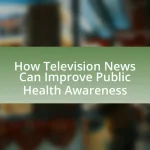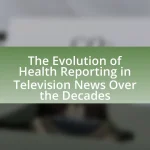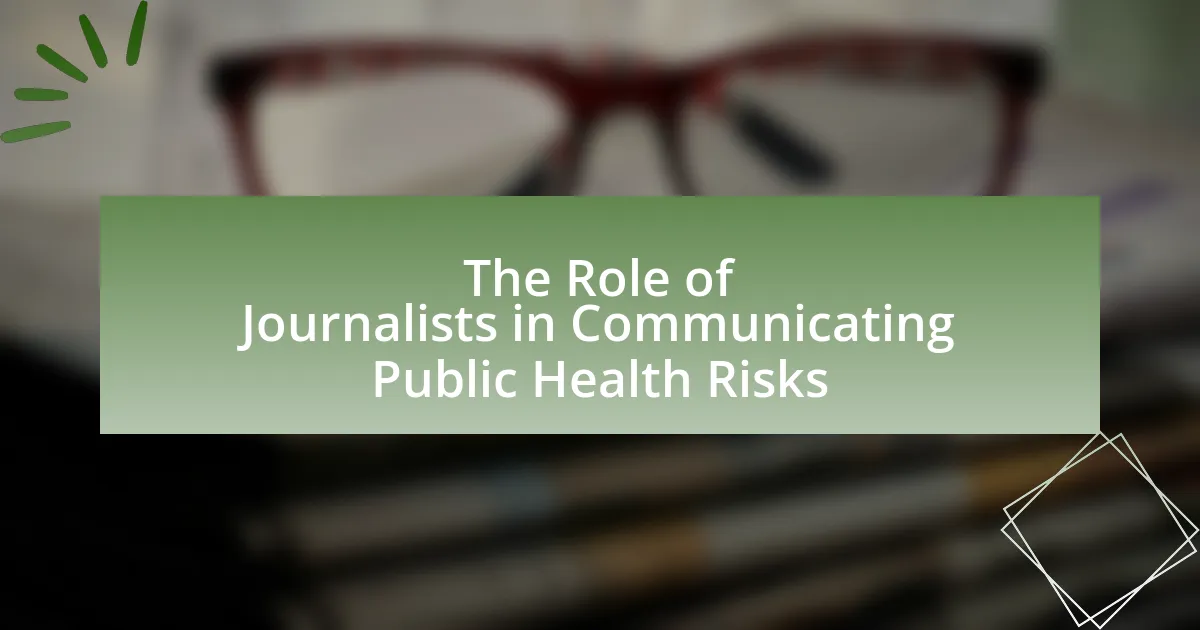Health reports in television news serve as informative segments that address medical issues, health trends, and public health concerns, emphasizing scientific accuracy and public health implications. These reports cover a range of topics, including chronic diseases, mental health, nutrition, and preventive care, while audience demographics influence their content and presentation style. The article examines the importance of accuracy in health reporting, the consequences of misinformation, and the role of sensationalism in shaping public perception. It also outlines best practices for viewers to critically evaluate health news, identify credible sources, and differentiate between sensationalized and factual reporting, ultimately highlighting the ethical considerations and responsibilities of health journalists.
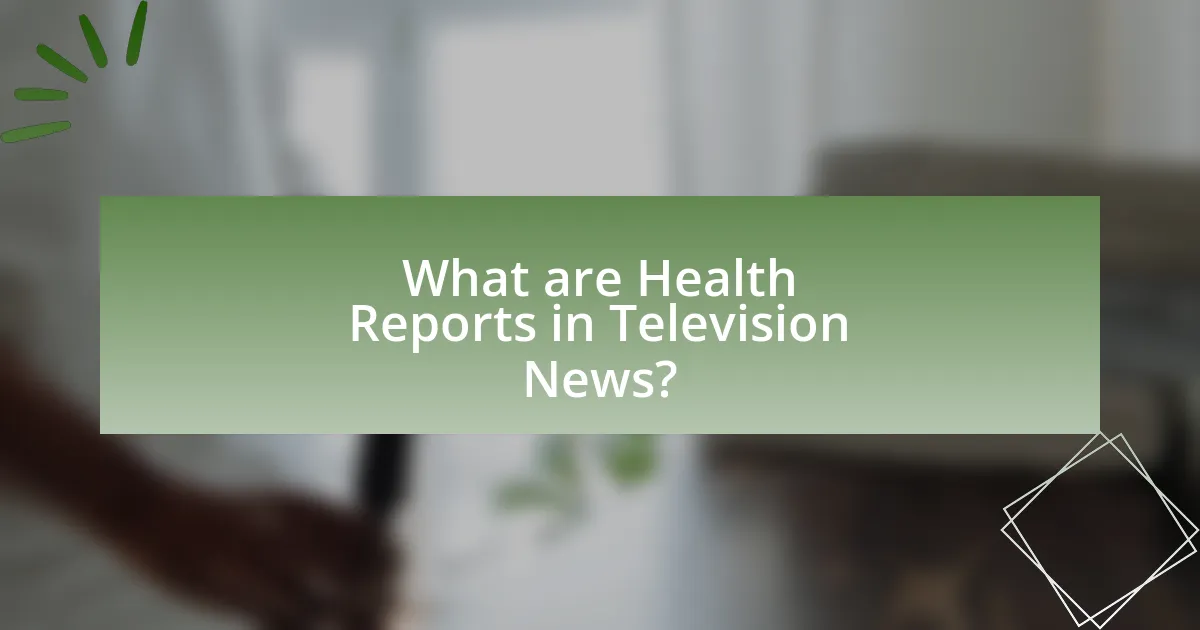
What are Health Reports in Television News?
Health reports in television news are segments that provide information on medical issues, health trends, and public health concerns. These reports aim to educate viewers about health-related topics, often featuring expert opinions, statistics, and case studies to support the information presented. For instance, a health report might cover the impact of a new vaccine, highlighting clinical trial results and expert commentary to ensure accuracy while engaging the audience.
How do Health Reports differ from other news segments?
Health reports differ from other news segments primarily in their focus on scientific accuracy and public health implications. Unlike general news segments that may prioritize entertainment or sensationalism, health reports are grounded in research and aim to inform viewers about medical advancements, health risks, and wellness strategies. For instance, health reports often rely on data from peer-reviewed studies and expert interviews, ensuring that the information presented is credible and relevant to public health. This emphasis on accuracy is crucial, as misinformation in health reporting can lead to public health crises, as seen during the COVID-19 pandemic when accurate health communication was vital for managing the outbreak.
What specific health topics are commonly covered in these reports?
Health reports commonly cover topics such as chronic diseases, mental health, nutrition, preventive care, and public health issues. These subjects are frequently highlighted due to their relevance to the general population and the impact they have on community well-being. For instance, chronic diseases like diabetes and heart disease are often discussed to raise awareness about their prevalence and management strategies. Mental health topics are increasingly featured, reflecting growing societal recognition of mental health’s importance. Nutrition and preventive care are also emphasized to promote healthier lifestyles and reduce healthcare costs. Public health issues, such as vaccination campaigns and disease outbreaks, are reported to inform and educate the public on critical health matters.
How do audience demographics influence the content of Health Reports?
Audience demographics significantly influence the content of health reports by determining the topics covered, the language used, and the presentation style. For instance, reports aimed at older adults often focus on chronic diseases and preventive care, while those targeting younger audiences may emphasize mental health and lifestyle choices. Research indicates that media outlets tailor their health content based on demographic factors such as age, gender, and socioeconomic status to enhance viewer engagement and relevance. A study by the Pew Research Center found that younger audiences prefer interactive and visually engaging content, prompting health reports to incorporate infographics and social media elements. This demographic-driven approach ensures that health information resonates with specific audience segments, ultimately affecting public health awareness and behavior.
Why is accuracy important in Health Reports?
Accuracy is crucial in health reports because it directly impacts patient safety and public health decisions. Inaccurate information can lead to misdiagnoses, inappropriate treatments, and increased health risks. For instance, a study published in the Journal of the American Medical Association found that misleading health information can result in patients making harmful choices regarding their health. Therefore, ensuring accuracy in health reporting is essential for maintaining trust in medical information and promoting informed decision-making among the public.
What are the potential consequences of inaccurate health information?
Inaccurate health information can lead to severe consequences, including misinformed health decisions, delayed treatment, and increased morbidity or mortality rates. For instance, a study published in the Journal of Medical Internet Research found that misinformation about vaccines resulted in lower vaccination rates, contributing to outbreaks of preventable diseases. Additionally, individuals relying on false health claims may engage in harmful behaviors, such as using unproven treatments, which can exacerbate health issues. The spread of inaccurate information undermines public trust in healthcare systems and professionals, further complicating efforts to promote accurate health messaging.
How can viewers identify credible health information in news reports?
Viewers can identify credible health information in news reports by evaluating the source of the information, checking for expert opinions, and verifying the data presented. Credible sources typically include established health organizations, peer-reviewed journals, and qualified professionals in the field. For instance, reports that cite the Centers for Disease Control and Prevention or the World Health Organization are generally more reliable. Additionally, viewers should look for information that is supported by scientific evidence, such as statistics from reputable studies, which enhances the credibility of the claims made in the report.
What role does sensationalism play in Health Reports?
Sensationalism in health reports serves to attract attention and increase viewership, often at the expense of accuracy. This practice can lead to the exaggeration of health risks or benefits, creating public fear or false hope. For instance, a study published in the Journal of Health Communication found that sensationalized health news can distort public perception of health issues, leading to misinformed health decisions. Such reporting can undermine trust in health information and professionals, as audiences may become skeptical of legitimate health advice when it is presented alongside exaggerated claims.
How does sensationalism affect public perception of health issues?
Sensationalism negatively affects public perception of health issues by exaggerating risks and creating fear. This distortion can lead to public panic, misinformed health decisions, and a lack of trust in legitimate health information. For instance, a study published in the Journal of Health Communication found that sensationalized media coverage of health risks, such as the Ebola outbreak, resulted in heightened anxiety among the public and increased demand for unnecessary medical interventions. Such reactions illustrate how sensationalism can skew public understanding and response to health matters, ultimately undermining effective health communication.
What techniques do news outlets use to create sensational health stories?
News outlets use techniques such as exaggerated headlines, emotional storytelling, and selective reporting to create sensational health stories. Exaggerated headlines often employ alarming language that captures attention, such as “miracle cure” or “epidemic,” which can mislead audiences about the severity or effectiveness of health information. Emotional storytelling engages viewers by focusing on personal anecdotes or dramatic narratives, making the content more relatable but potentially skewing the factual basis. Selective reporting involves highlighting specific studies or data that support a sensational claim while ignoring contradictory evidence, which can distort the overall understanding of health issues. These techniques are effective in attracting viewership but can compromise the accuracy and reliability of health information presented.
How can Health Reports balance sensationalism and accuracy?
Health reports can balance sensationalism and accuracy by adhering to rigorous journalistic standards and prioritizing evidence-based information. By utilizing peer-reviewed studies and expert opinions, health reports can present factual data while avoiding exaggerated claims. For instance, a study published in the Journal of Health Communication found that reports grounded in scientific research significantly reduce the likelihood of sensationalism, thereby enhancing public trust. Additionally, employing clear language and context helps audiences understand the nuances of health information, further mitigating sensationalist tendencies.
What are the ethical considerations in reporting health news?
Ethical considerations in reporting health news include accuracy, transparency, and the potential impact on public health. Journalists must ensure that the information presented is factually correct and based on credible sources, as misinformation can lead to public panic or harmful behaviors. Transparency involves disclosing the sources of information and any potential conflicts of interest, which helps maintain trust with the audience. Additionally, reporters should consider the implications of sensationalism, as exaggerated claims can distort public perception of health issues and lead to misinformed decisions. For instance, a study published in the Journal of Health Communication highlights that sensationalized health news can significantly influence public attitudes and behaviors regarding health risks.
How do journalists ensure ethical standards in Health Reports?
Journalists ensure ethical standards in health reports by adhering to established guidelines, verifying information, and prioritizing accuracy over sensationalism. They follow ethical codes from organizations such as the Society of Professional Journalists, which emphasize truthfulness, accuracy, and fairness. Additionally, journalists often consult with medical experts and rely on peer-reviewed studies to substantiate claims, ensuring that the information presented is credible and scientifically sound. This commitment to ethical reporting helps maintain public trust and promotes informed decision-making regarding health issues.
What guidelines exist for responsible health reporting?
Responsible health reporting guidelines include accuracy, clarity, and context. Journalists must ensure that health information is factually correct, using credible sources such as peer-reviewed studies and expert opinions. Clarity involves avoiding medical jargon and presenting information in an understandable manner for the general public. Providing context is essential; this means explaining the significance of health findings, including potential risks and benefits, to prevent misinterpretation. Additionally, responsible reporting should avoid sensationalism, which can lead to public panic or misinformation. These guidelines are supported by organizations like the American Medical Association and the World Health Organization, which emphasize the importance of ethical standards in health communication.
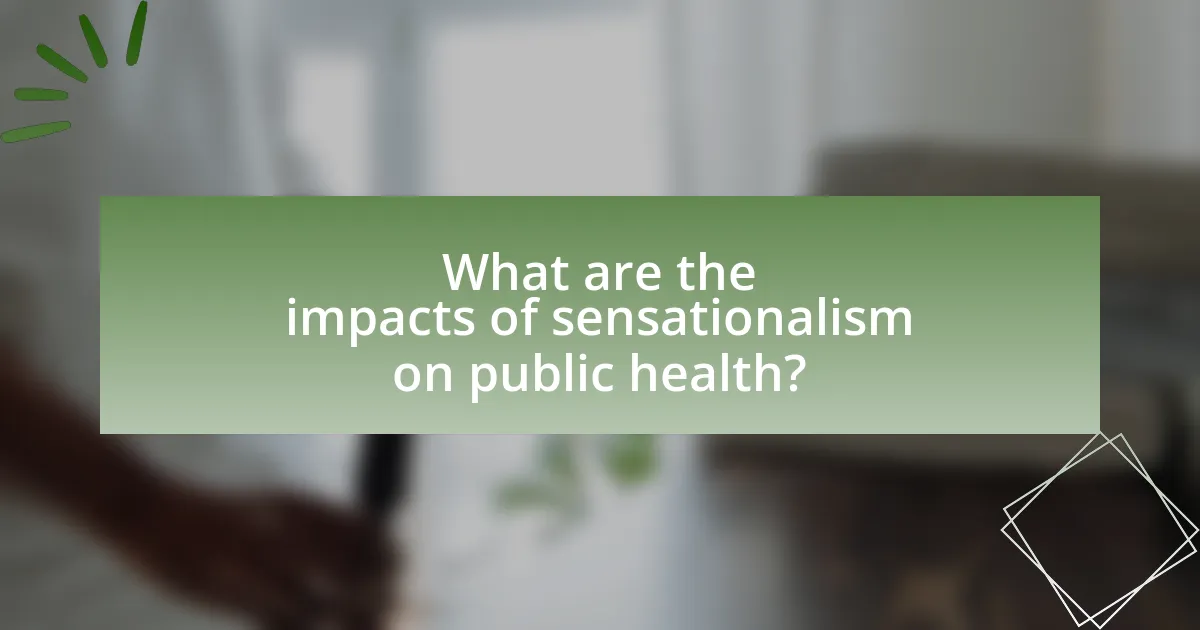
What are the impacts of sensationalism on public health?
Sensationalism negatively impacts public health by distorting information, leading to public panic and misinformation. For instance, exaggerated reporting on health risks can cause unnecessary fear, prompting individuals to avoid necessary medical treatments or vaccinations. A study published in the Journal of Health Communication found that sensationalized news coverage of the H1N1 influenza pandemic led to increased anxiety and confusion among the public, ultimately affecting vaccination rates. This demonstrates that sensationalism can undermine public health initiatives by creating a climate of distrust and fear, which hinders effective health communication and response.
How does sensationalism influence health behaviors in the audience?
Sensationalism significantly influences health behaviors in the audience by amplifying fear and urgency regarding health issues. This heightened emotional response can lead to increased health-related anxiety, prompting individuals to adopt preventive measures or seek medical advice more urgently. For instance, a study published in the Journal of Health Communication found that sensationalized news coverage of disease outbreaks led to a 30% increase in public interest in vaccination and preventive health behaviors. This demonstrates that sensationalism can effectively drive audience engagement and behavioral change, albeit often based on exaggerated or misleading information.
What examples illustrate the impact of sensational health reporting?
Sensational health reporting can lead to public panic and misinformation, as illustrated by the 2009 H1N1 influenza pandemic coverage. Media outlets exaggerated the severity of the outbreak, leading to widespread fear and unnecessary stockpiling of antiviral medications. Additionally, the reporting on the MMR vaccine and its alleged link to autism, which was later discredited, resulted in a significant decline in vaccination rates and subsequent outbreaks of preventable diseases. These examples demonstrate how sensationalism can distort public perception and behavior regarding health issues.
How can sensationalism lead to misinformation during health crises?
Sensationalism can lead to misinformation during health crises by exaggerating facts and creating panic, which distorts public understanding of the situation. For instance, during the Ebola outbreak in 2014, media outlets often focused on dramatic stories and images, overshadowing critical information about transmission and prevention. This resulted in widespread fear and misconceptions, as evidenced by a study published in the journal “Health Communication,” which found that sensational reporting contributed to public anxiety and confusion about the disease. Such misinformation can hinder effective public health responses and compliance with health guidelines.
What strategies can news organizations implement to improve accuracy?
News organizations can improve accuracy by implementing rigorous fact-checking processes. This involves establishing dedicated teams that verify information before publication, utilizing reliable sources, and cross-referencing data with multiple credible outlets. For instance, a study by the American Press Institute found that news organizations that adopted systematic fact-checking saw a significant reduction in misinformation, enhancing their credibility and audience trust. Additionally, training journalists in media literacy and critical thinking can further bolster the accuracy of health reports, ensuring that they discern credible information from sensationalized claims.
How can collaboration with health experts enhance report credibility?
Collaboration with health experts enhances report credibility by ensuring that the information presented is accurate, evidence-based, and aligned with current medical standards. Health experts possess specialized knowledge and training that allows them to evaluate the validity of health claims, thereby reducing the risk of misinformation. For instance, studies have shown that reports vetted by medical professionals are more likely to be trusted by the public, as evidenced by a 2019 survey indicating that 78% of viewers prefer health news that includes expert commentary. This collaboration not only bolsters the factual integrity of the report but also fosters public trust, as audiences are more inclined to believe information that is supported by qualified authorities in the field.
What role does fact-checking play in health journalism?
Fact-checking plays a critical role in health journalism by ensuring the accuracy and reliability of health information disseminated to the public. This process helps to prevent the spread of misinformation, which can lead to public health risks, as seen during health crises like the COVID-19 pandemic where false claims about treatments and vaccines proliferated. By verifying facts before publication, health journalists uphold ethical standards and contribute to informed decision-making among audiences, ultimately fostering trust in health reporting.
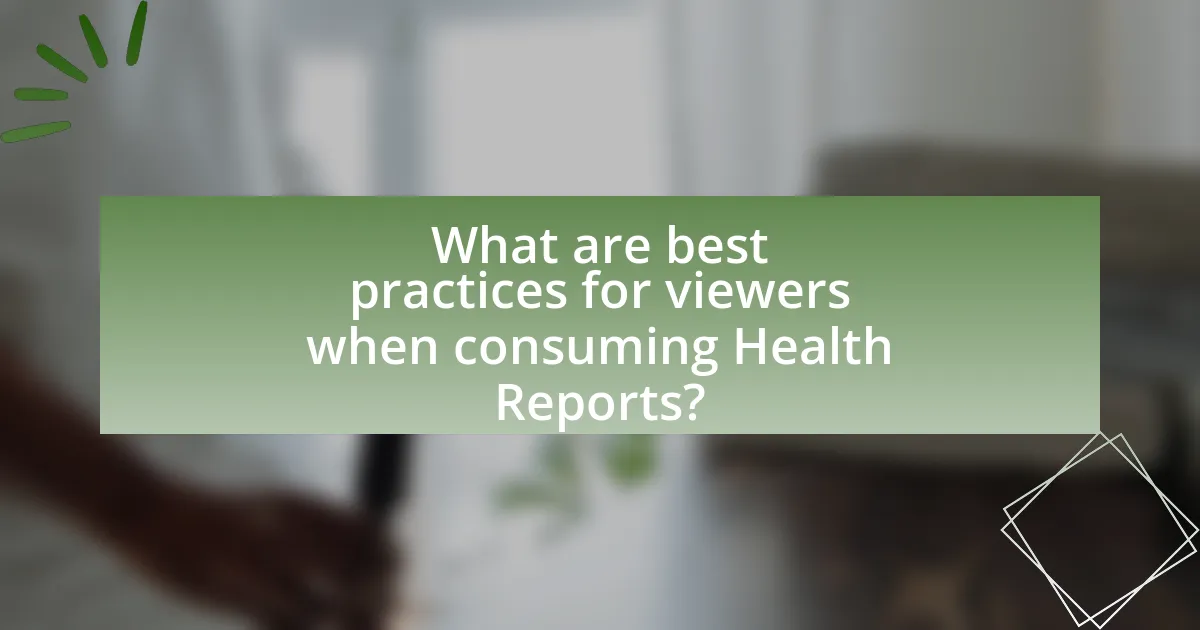
What are best practices for viewers when consuming Health Reports?
Viewers should critically evaluate health reports by verifying the credibility of the source, understanding the context of the information presented, and seeking additional perspectives. Credible sources include established medical institutions and peer-reviewed journals, which provide reliable data. Understanding the context involves recognizing the limitations of the study or report, such as sample size or methodology, which can affect the validity of the findings. Additionally, seeking multiple viewpoints helps to mitigate bias and provides a more comprehensive understanding of the health issue being reported. These practices are essential for making informed health decisions based on accurate information rather than sensationalized claims.
How can viewers critically evaluate health news reports?
Viewers can critically evaluate health news reports by assessing the credibility of the source, examining the evidence presented, and identifying potential biases. Credible sources typically include established health organizations, peer-reviewed journals, or qualified experts in the field. For instance, a report citing data from the Centers for Disease Control and Prevention (CDC) or the World Health Organization (WHO) is more reliable than one from an unverified blog.
Additionally, viewers should analyze the evidence provided, looking for specific studies or statistics that support the claims made in the report. Reports that reference peer-reviewed research, such as those published in journals like The New England Journal of Medicine, offer a stronger foundation for their assertions.
Finally, recognizing potential biases is crucial; sensationalized headlines or emotionally charged language may indicate an attempt to provoke a reaction rather than inform. Evaluating these aspects allows viewers to discern the accuracy and reliability of health news reports effectively.
What questions should viewers ask to assess the reliability of health information?
Viewers should ask the following questions to assess the reliability of health information: Who is providing the information? What are their qualifications and expertise in the subject matter? Is the information supported by credible sources, such as peer-reviewed studies or reputable health organizations? Are there any potential conflicts of interest that could bias the information? Is the information current and up-to-date? Are multiple viewpoints presented, or is the information one-sided? These questions help ensure that the health information is credible and trustworthy, as research indicates that reliable health information typically comes from qualified professionals and is backed by scientific evidence.
How can viewers differentiate between sensationalism and factual reporting?
Viewers can differentiate between sensationalism and factual reporting by critically analyzing the language and presentation of news stories. Sensationalism often employs exaggerated headlines, emotionally charged language, and dramatic visuals to provoke a strong emotional response, while factual reporting focuses on clear, objective language, providing evidence and context. For example, a study by the Pew Research Center found that sensational headlines can lead to misinterpretation of health information, highlighting the importance of scrutinizing the source and checking for supporting data. By assessing the tone, verifying claims with credible sources, and looking for balanced perspectives, viewers can better discern between sensationalized content and accurate reporting.
What resources are available for accurate health information?
Accurate health information can be found through reputable sources such as the Centers for Disease Control and Prevention (CDC), the World Health Organization (WHO), and peer-reviewed medical journals. These organizations provide evidence-based guidelines, research findings, and health statistics that are essential for informed decision-making. For instance, the CDC offers comprehensive data on disease prevention and health promotion, while the WHO focuses on global health issues and standards. Peer-reviewed journals, such as The New England Journal of Medicine, publish studies that undergo rigorous evaluation by experts in the field, ensuring the reliability of the information presented.
Which reputable organizations provide reliable health data and news?
Reputable organizations that provide reliable health data and news include the World Health Organization (WHO), the Centers for Disease Control and Prevention (CDC), and the National Institutes of Health (NIH). The WHO is recognized globally for its authoritative health information and guidelines, particularly during health emergencies. The CDC is a leading national public health institute in the United States, known for its data on disease prevention and health promotion. The NIH is the primary agency for conducting and supporting medical research in the U.S., providing extensive health-related information and research findings. These organizations are widely cited in academic and professional contexts, ensuring their data is credible and trustworthy.
How can viewers stay informed about health issues without falling for sensationalism?
Viewers can stay informed about health issues without falling for sensationalism by critically evaluating sources of information and prioritizing reputable outlets. Trusted sources include peer-reviewed journals, government health agencies, and established medical organizations, which provide evidence-based information. For instance, the Centers for Disease Control and Prevention (CDC) and the World Health Organization (WHO) regularly publish accurate health data and guidelines. Additionally, viewers should be cautious of headlines that evoke strong emotional reactions, as these often indicate sensationalism. By cross-referencing information from multiple credible sources, individuals can discern factual content from exaggerated claims, ensuring a more accurate understanding of health issues.

